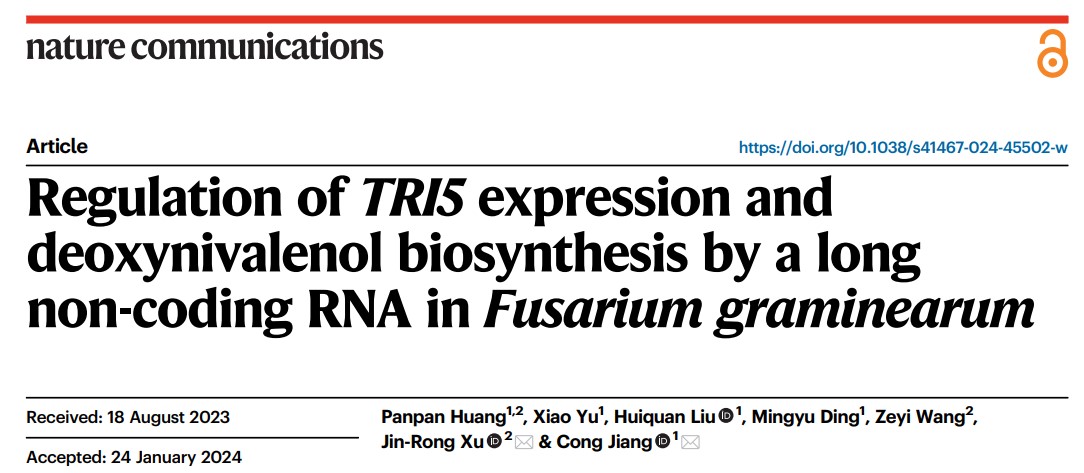Recently, the Functional Genomics of Plant Pathogenic Fungi Research Team from our college has published a research paper titled "Regulation of TRI5 expression and deoxynivalenol biosynthesis by a long non-coding RNA in Fusarium graminearum" in the journal "Nature Communications". Huang Panpan, Ph.D student, is the first author of this paper, Prof. Jiang Cong from our college is the co-corresponding authors.

In this study, multiple long non-coding RNAs (LncRNAs) were identified in the TRI gene cluster through strand-specific RNA-seq, and their mode of action was deeply analyzed. Among them, RNA5P is responsible for regulating the expression of the TRI5 gene (encoding the key enzyme for DON toxin synthesis) under the control of Tri6. Compared to the direct regulation of transcription factors, this regulatory mechanism can achieve a "double insurance" effect, effectively avoiding the invalid activation of DON toxin synthesis genes while ensuring the massive synthesis of DON toxins during necessary periods. This is the first report of LncRNA in regulating secondary metabolism in filamentous fungi, expanding our understanding of the functional pathways of LncRNA and providing new ideas for deciphering the mechanism of DON toxin synthesis and developing DON toxin interference technology.Wheat scab is a worldwide crop fungal disease. In recent years, with climate change and changes in farming systems, this disease has spread westward and northward, showing a high incidence and posing a major threat to China's food production. Fusarium graminearum is the main pathogenic bacterium of wheat scab. During the infection period, it is induced by environmental and plant factors to synthesize a large amount of fungal toxins such as deoxynivalenol (DON), which helps the infecting hyphae expand in the wheat rachis. DON toxin also inhibits eukaryotic protein synthesis, posing a significant threat to human and animal health. Currently, the issue of toxins has become a key and difficult point in the prevention and control of wheat scab. Effectively inhibiting the biosynthesis of DON toxins in Fusarium graminearum is a crucial link in controlling wheat scab, and understanding the regulatory mechanism of DON toxins is an important basis for formulating strategies to inhibit toxin production and prevent disease.The synthesis of DON toxins in Fusarium graminearum is catalyzed in an ordered manner by enzymes encoded by the TRI genes, most of which are distributed in a gene cluster. A deep understanding of this gene cluster is the key to revealing the regulatory mechanism of DON toxins. In this study, through strand-specific RNA-seq, it was identified that there are antisense RNAs for three TRI genes in the TRI gene cluster, namely TRI5, TRI6, and TRI11. This indicates that the regulation in the TRI gene cluster is more complex than traditionally believed. Further exploration of the formation and function of antisense RNAs revealed that antisense RNAs of TRI6 and TRI5 act on their sense transcripts to inhibit the synthesis of DON toxins. In addition, there is a transcript upstream of TRI5 that is expressed at a low level in wild-type strains but significantly increased in tri6 mutants. By constructing frameshift mutant strains and detecting fusion proteins, the possibility that this transcript encodes a small protein was excluded, and it was speculated to be an LncRNA, named RNA5P. Through promoter replacement and ectopic insertion, it was confirmed that the function of RNA5P is highly dependent on its position in the genome. Overexpression of RNA5P in situ has a strong inhibitory effect on TRI5 transcription and DON toxin synthesis. Analysis of the promoter of RNA5P identified a potential Tri6 binding site. Mutation of this site caused abnormal expression of RNA5P, leading to changes in TRI5 transcription levels and disruption of toxin synthesis. This reveals a new mode of Tri6 regulating gene expression and toxin synthesis by controlling LncRNA expression. As the first identified LncRNA responsible for secondary metabolism regulation in filamentous fungi, RNA5P plays an important role as a bridge for Tri6 to regulate TRI5 expression, which is crucial for precisely controlling the initiation of DON toxin biosynthesis.

Tri6 regulates the expression of TRI5 gene and DON toxin synthesis through RNA5P
This research work was funded by the National Key Research and Development Program, the National Natural Science Foundation of China, and others. The State Key laboratory for Crop Stress Resistance and High-Efficiency Production provided technical support for the completion of it.
Original link: https://www.nature.com/articles/s41467-024-45502-w